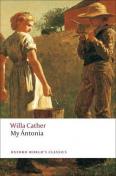BKMT READING GUIDES
My Antonia (Oxford World's Classics)
by Willa Cather
Paperback : 272 pages
4 clubs reading this now
2 members have read this book
Introduction
(My Antonia is a classic tale of pioneer life in the American Midwest. The novel details daily life in the newly settled plains of Nebraska through the eyes of Jim Burden, who recounts memories of a childhood shared with a girl named Antonia Shimerda, the daughter of a family who have emigrated from Bohemia. As adults, Jim leaves the prairie for college and a career in the east, while Antonia devotes herself to her large family and productive farm. When he returns Jim sees that although Antonia is careworn, she remains "a rich mine of life, like the founders of early races,". Full of stirring descriptions of the prairie's beautiful yet terrifying landscape, and the rich ethnic mix of immigrants and native-born Americans who chose to restart their lives there, My Antonia mythologized a period of American history that was lost before its value could be understood.
This new edition provides a critically up-to-date introduction and detail notes which put the events and themes of the book in full historical context. Also included are Cather's original and revised introductions to her novel.
It seems almost sacrilege to infringe upon a book as soulful and rich as Willa Cather's My �ntonia by offering comment. First published in 1918, and set in Nebraska in the late 19th century, this tale of the spirited daughter of a Bohemian immigrant family planning to farm on the untamed land ("not a country at all but the material out of which countries are made") comes to us through the romantic eyes of Jim Burden. He is, at the time of their meeting, newly orphaned and arriving at his grandparents' neighboring farm on the same night her family strikes out to make good in their new country. Jim chooses the opening words of his recollections deliberately: "I first heard of �ntonia on what seemed to be an interminable journey across the great midland plain of North America," and it seems almost certain that readers of Cather's masterpiece will just as easily pinpoint the first time they heard of �ntonia and her world. It seems equally certain that they, too, will remember that moment as one of great light in an otherwise unremarkable trip through the world.
�ntonia, who, even as a grown woman somewhat downtrodden by circumstance and hard work, "had not lost the fire of life," lies at the center of almost every human condition that Cather's novel effortlessly untangles. She represents immigrant struggles with a foreign land and tongue, the restraints on women of the time (with which Cather was very much concerned), the more general desires for love, family, and companionship, and the great capacity for forbearance that marked the earliest settlers on the frontier.
As if all this humanity weren't enough, Cather paints her descriptions of the vastness of nature--the high, red grass, the road that "ran about like a wild thing," the endless wind on the plains--with strokes so vivid as to make us feel in our bones that we've just come in from a walk on that very terrain ourselves. As the story progresses, Jim goes off to the University in Lincoln to study Latin (later moving on to Harvard and eventually staying put on the East Coast in another neat encompassing of a stage in America's development) and learns Virgil's phrase "Optima dies ... prima fugit" that Cather uses as the novel's epigraph. "The best days are the first to flee"--this could be said equally of childhood and the earliest hours of this country in which the open land, much like My �ntonia, was nothing short of a rhapsody in prairie sky blue. --Melanie Rehak
Discussion Questions
No discussion questions at this time.Book Club Recommendations
Recommended to book clubs by 6 of 8 members.
Book Club HQ to over 88,000+ book clubs and ready to welcome yours.
Get free weekly updates on top club picks, book giveaways, author events and more








